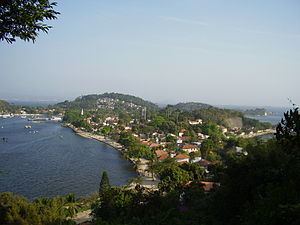Max length 2.3 km | ||
 | ||
Points of interest Parque Natural Municipal, Praia da Moreninha, Praia pintor Castagneto Similar Guanabara Bay, Joatinga Beach, Quinta da Boa Vista, Praia da Moreninha, Rio–Niterói Bridge | ||
Oasis the meaning of soul rio de janeiro 2009
Paquetá Island (Portuguese: Ilha de Paquetá) is an island in Guanabara Bay, Rio de Janeiro. The name of the island is a Tupi word meaning "many pacas". The island is an auto-free zone, so travel is limited to bicycles and horse-drawn carriages. Paquetá has twenty baobabs, a type of African tree - the only ones in Brazil beside the Baobá in Passeio Público in Fortaleza. One of the trees is called "Maria Gorda" (Maria, the Fatty), which residents kiss for luck.
Contents
- Oasis the meaning of soul rio de janeiro 2009
- Map of PaquetC3A1 Island PaquetC3A1 Rio de Janeiro State of Rio de Janeiro Brazil
- History
- Traditional events
- References
Map of Paquet%C3%A1 Island - Paquet%C3%A1, Rio de Janeiro - State of Rio de Janeiro, Brazil
History
Up to the end of the 15th century, the Tamoio Indians used Paquetá as hunting and living grounds. It was officially registered by the Frenchman André Thevet in December 1555, and acknowledged by King Henri II as a French discovery in 1556. Together with Paranapuã Island (now called Governador Island), Paquetá was one of the main centers of French resistance to Portuguese occupation. While the French had the Tamoios as their allies, the Temiminós Indians led by Araribóia supported the Portuguese.
The Portuguese victory was consolidated with the expulsion of the French and the defeat of the Tamoios. Paquetá was then divided into two allotments assigned to settlers; the one now called Campo was given to Inácio de Bulhões and the Ponte area to Fernão Valdez. Even today the characteristics of this division between Campo and Ponte are conspicuously present in the Island's festivities, in football matches and in the parade of dancing and singing groups during Carnival.
Under Portuguese rule, Paquetá produced vegetables, fruits, stone and timber for construction. Aristocratic land and slave owners occupied the island. Nowadays Paquetá presents a residential and touristy profile due to its cultural roots, its scenery and location.
